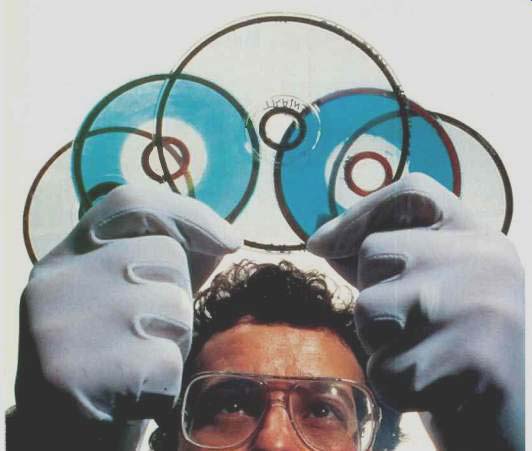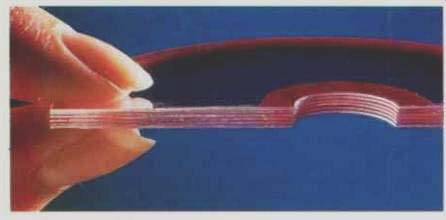Songs on a Sandwich

above: IBM researcher Kurt Rubin holding two-layer optical discs that can be sandwiched together as shown below.
The guy wearing the gloves, Kurt Rubin of IBM's Almaden Research Center, seems to be holding five discs. But you could, say he's holding 10-or one; it all depends on how you look at it.
Each of the discs in Mr. Rubin's hand is a two-layer optical recording, and these recordings are de- signed to be sandwiched together into a disc with up to 10 recording layers and a corresponding increase in information-storage capacity.
Such a sandwich disc would be quite fat (about a half-inch thick, in IBM's initial mockup) because it would include not only the five two-layer data carriers but spacers between carrier discs and a rigid plastic substrate like that on today's CDs. In practice, says IBM, discs with four or more layers will be made of thinner materials.
The experimental disc system re lies on optical disc equipment's extremely shallow depth of focus. To day's optical drives focus so finely, IBM says, that "light focused on any layer is 10,000 to 100,000 times more intense than that hitting any adjacent layer." The reflective backings used on today's CDs and LaserDiscs cannot be used on a multi-layer disc, as they would block the passage of light to other layers. Instead, the system re lies on a balance between transparency of the layers and reflectivity of the surfaces and requires higher powered lasers than today's CD players do. The number of surfaces in a disc stack is limited by laser power, layer transparency, and cost.
Pre-recorded discs could have more layers than recordable ones, since recordable discs must be able to absorb some of the laser light during recording. However, players built to handle multi-layer discs would still be able to play today's single-layer audio, video, and data discs.

This experimental IBM system is also compatible with systems that raise data capacity by using shorter wavelength (blue) lasers or lenses with high numerical apertures for more precise focus. Such systems are being worked on by 3M, Sony, IBM, and many others.
It's unlikely that 10-layer audio CDs will ever appear, for the same reason 10-CD albums aren't around now-too little material whose length would justify this. But CDs with two to four layers would make sense, and adapting today's player designs to handle them might not be difficult. (Retrofitting existing players might not be cost-effective, though.) Today's players already have movable lenses to maintain focus even on warped discs. The Alamaden researchers have found that it took only "relatively minor modifications" to adapt an existing CD ROM drive to play audio and video tracks on two-layer, read-only discs.
CD Wins--At Last?
If trends continue, 1994 will be the first year that CD became the world's most popular recorded sound carrier. In 1993, according to the International Federation of the Phono graph Industry (IFPI), cassette sales dropped for the first time. The drop was a mere 2%, but combined with a 19.4% rise in CD sales from 1992 to 1993, it was enough to bring CD sales to more than 96% of cassette sales figures.
Cassettes continue to be the dominant medium in developing countries, but Compact Discs are the largest sellers in nine of the 10 countries that buy the most recorded music. And in the 10th such country, Mexico, cassette sales for 1993 dropped 19% while CD sales rose by 39.3%.
================
Speakers From Space

================
Hearing About Hearing
A workshop on "What We Know About Hearing" will be presented from Thursday, August 18 to Saturday, August 20, at the Indiana University School of Music, in Bloomington, Ind. The workshop is presented by Synergetic Audio Concepts (Syn Aud-Con), a group which has long been engaged in additional education for sound professionals.
The workshop staff will consist of Dr. Jont Allen of Bell Laboratories, Dr. Larry Humes of the Indiana University Speech and Hearing Department, and Dr. Mead Killion of Etymotic, Inc. The conference will cover the ways listener physiology affects the sound reaching the eardrum, and how sound technology can exploit these factors.
For more information, contact Syn Aud-Con at 12370 W. Co. Rd., 100 N, Nor man, Ind. 47264. Telephone number is 812-995-8212, fax is 812-995-2110.
AR Heads West
The centers of the U.S. speaker industry have long been California (where the movie industry is) and the Boston/Cambridge area (where Acoustic Research was founded, in the 1950s). The presence of AR, which once dominated the speaker industry, built up a rich stock of speaker-building expertise, and a proliferation of speaker companies. Such companies as Advent, Allison, Boston Acoustics, Cambridge SoundWorks, KLH, RDL, Snell, and others can trace their ancestry back to AR. Today, even such British companies as Celestion and KEF are headquartered in the area.
So it came as something of a shock to learn that, after 40 years or so in Massachusetts, AR was moving to Benicia, Cal.
There, it will be part of the new Specialty Audio Group of International Jensen, AR's owner for the past four years.
The AR Powered Partners' line of small, self-powered speakers will now be handled by Advent, another Jensen-owned company founded in the Boston area, which also once dominated the loudspeaker field.
Even AR's new location has some historical resonance: A plaque in the nearby town of Napa honors a speaker pioneer who long preceded that company: Peter Jensen.
+++++++++++++++
(adapted from Audio magazine, Aug. 1994)
= = = =